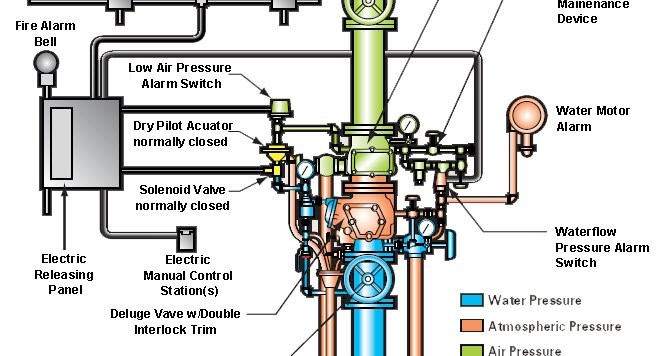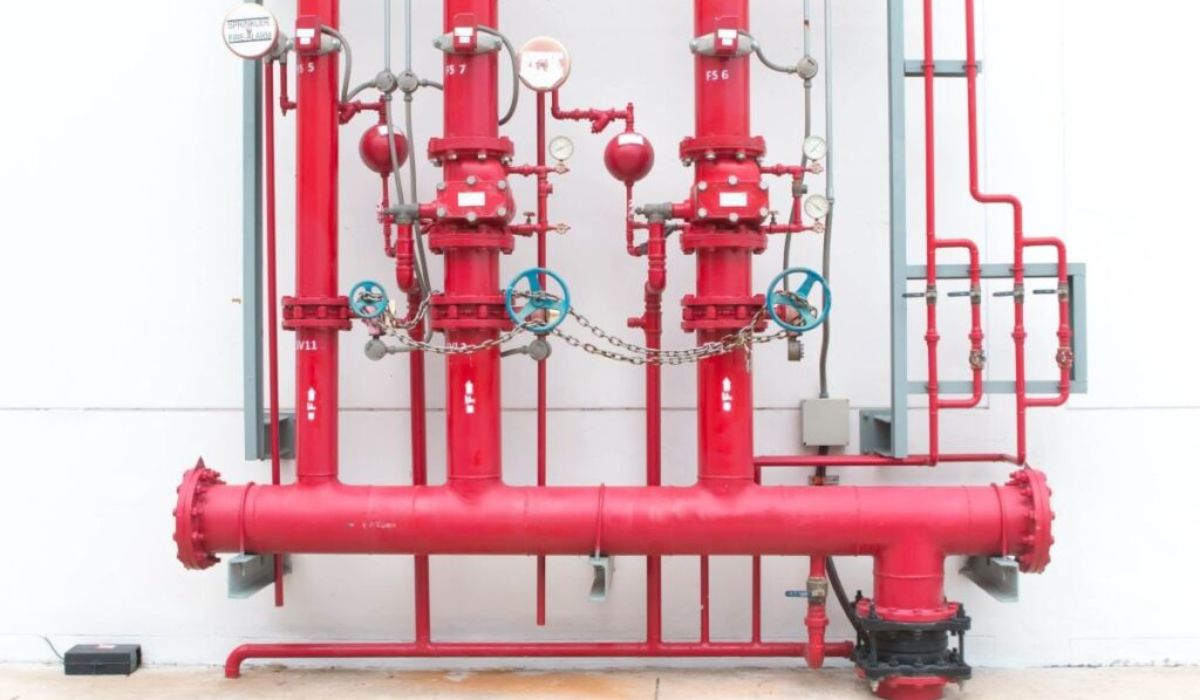A Preaction Sprinkler System is a fire protection system that combines dry pipe and wet pipe sprinkler features. It requires two triggers to activate, ensuring greater protection against accidental discharge.
Preaction Sprinkler Systems are popular in environments where accidental water damage must be minimized, such as data centers and libraries. These systems provide a higher level of security by requiring both a fire detection event and a secondary trigger before water is released.
This dual-trigger mechanism helps prevent unnecessary water damage and ensures that water is only discharged when absolutely necessary. By combining the advantages of both dry and wet pipe systems, Preaction Sprinkler Systems offer reliable and effective fire protection tailored to sensitive areas.
Introduction To Preaction Sprinkler Systems
Preaction sprinkler systems are advanced fire protection solutions. They combine elements of dry and wet systems. These systems are highly reliable and prevent accidental water damage.
Importance In Fire Safety
Preaction sprinkler systems offer crucial protection in fire emergencies. They activate only when two conditions are met. First, a fire detection device must sense heat or smoke. Second, the sprinkler head must open due to high temperature.
This dual-action reduces false alarms. It also limits unnecessary water discharge. Preaction systems are ideal for environments with sensitive equipment. Museums, data centers, and libraries benefit greatly from these systems.
Basic Components
A preaction sprinkler system consists of several key parts. Each part plays a vital role in the system’s efficiency. Here are the main components:
- Fire Detection Device: Senses heat or smoke to trigger the system.
- Preaction Valve: Controls the flow of water into the piping system.
- Sprinkler Heads: Release water when the temperature reaches a certain level.
- Alarm System: Alerts occupants and emergency services.
| Component | Function |
|---|---|
| Fire Detection Device | Senses heat or smoke to trigger the system. |
| Preaction Valve | Controls the flow of water into the piping system. |
| Sprinkler Heads | Release water when the temperature reaches a certain level. |
| Alarm System | Alerts occupants and emergency services. |
How Preaction Systems Work
A Preaction Sprinkler System is a fire protection system. It only activates when specific conditions are met. This makes it suitable for areas where accidental water discharge could damage property.
Activation Process
The activation process of a Preaction System is crucial. It involves multiple steps to ensure safety. Here is a simplified breakdown:
- Detection: A smoke or heat detector senses a fire.
- Preaction Valve: The preaction valve opens, allowing water into the pipes.
- Sprinkler Heads: The sprinkler heads release water only when they are heated.
These steps ensure water is only released in a confirmed fire event. This reduces the risk of accidental water damage.
Types Of Preaction Systems
There are three main types of Preaction Systems. Each serves different needs:
- Single Interlock: Activates when the detection system senses a fire.
- Double Interlock: Requires both a detection system and a sprinkler head to activate.
- Non-Interlock: Activates when either the detection system or a sprinkler head is triggered.
Here is a table summarizing the differences:
| Type | Activation Requirements | Best For |
|---|---|---|
| Single Interlock | Detection System | General use |
| Double Interlock | Detection System + Sprinkler Head | High-value areas |
| Non-Interlock | Detection System or Sprinkler Head | Quick response needed |
Select the right type for your specific needs. This ensures optimal protection and minimal damage.
Single Interlock Systems
A Single Interlock System is a type of preaction sprinkler system. It is designed to offer extra protection against accidental water discharge. This system is commonly used in environments where water damage can be costly.
Operation Mechanism
The operation mechanism of a single interlock system is straightforward. It requires two events to occur before water is released.
First, a fire detection device, like a smoke or heat detector, must activate. This triggers the preaction valve to open, allowing water to fill the pipes.
Second, a sprinkler head must activate due to heat, allowing water to discharge and control the fire. This dual-action mechanism provides a high level of reliability and reduces the risk of accidental water damage.
Typical Applications
Single interlock systems are ideal for areas where accidental water damage is a concern. Typical applications include:
- Data Centers
- Libraries
- Museums
- Archives
- Telecommunication Facilities
These environments house sensitive equipment and materials that water can easily damage. Therefore, a single interlock system offers the perfect balance of fire protection and water damage prevention.
| Application | Reason |
|---|---|
| Data Centers | Protects costly servers and data storage |
| Libraries | Prevents damage to books and documents |
| Museums | Safeguards valuable artifacts and artwork |
| Archives | Preserves important historical records |
| Telecommunication Facilities | Ensures integrity of communication equipment |
Double Interlock Systems
A Double Interlock System is a specific type of preaction sprinkler system. It provides an added layer of protection against accidental discharge. This system requires two separate triggers before water is released into the piping.
How They Differ
Double Interlock Systems are unique. They need two events to happen before activating. First, a detection device must sense a fire. Second, the sprinkler head must break due to heat.
This dual requirement prevents accidental water damage. Other systems may activate with just one trigger. The double interlock method ensures a higher level of safety and reliability.
Ideal Usage Scenarios
Double Interlock Systems are perfect for sensitive areas. These include data centers, museums, and archives. Such places need extra precautions to protect valuable items.
They are also suitable for cold storage facilities. The risk of accidental activation can be costly in these settings. By requiring two triggers, the system reduces such risks significantly.
| Feature | Double Interlock | Single Interlock |
|---|---|---|
| Activation | Two Triggers Needed | One Trigger Needed |
| Ideal For | High-Value Areas | General Use |
| Risk of Accidental Activation | Lower | Higher |
- Requires fire detection and heat to activate
- Reduces risk of accidental water damage
- Best for areas with valuable or sensitive materials
Preaction System Benefits
Preaction sprinkler systems offer significant advantages. They provide enhanced protection and minimize water damage. These benefits make them ideal for sensitive environments.
Enhanced Protection
Preaction systems provide enhanced protection by requiring two triggers before activation. This reduces the risk of accidental discharge. They are highly reliable and reduce false alarms. Sensitive areas like museums and data centers benefit greatly.
Minimized Water Damage
Preaction systems minimize water damage. Water is only released when both triggers are activated. This feature is crucial for protecting valuable assets. It ensures that water is not wasted and keeps damage to a minimum.
| Feature | Benefit |
|---|---|
| Two-Trigger Activation | Reduces false alarms |
| Selective Water Release | Minimizes water damage |
- Suitable for sensitive areas
- Highly reliable
- Prevents unnecessary water discharge
These benefits make preaction systems a top choice. They ensure safety and protect valuable assets effectively.

Common Installation Areas
Preaction sprinkler systems are essential for protecting sensitive environments. They help prevent unnecessary water damage. Below, we explore some common installation areas.
Data Centers
Data centers house critical IT infrastructure. They need protection from fire and water damage. A preaction sprinkler system is ideal here. It ensures that water is released only when a fire is confirmed.
- Reduces risk of accidental discharge.
- Protects expensive equipment.
- Minimizes downtime.
Data centers often use double interlock systems. These systems need both heat and smoke detection to activate. This dual-detection system minimizes false alarms.
Museums And Archives
Museums and archives store invaluable items. They must be protected from both fire and water. Preaction systems are perfect for these settings.
- Prevents accidental water damage.
- Ensures artifacts remain safe.
- Maintains environmental control.
Museums often use single interlock systems. These systems activate only when a fire is detected. This helps protect delicate and irreplaceable items.
Maintenance And Testing
Maintaining and testing a Preaction Sprinkler System ensures it works during emergencies. Regular checks and tests prevent potential failures and costly repairs.
Routine Checks
Routine checks are essential for the Preaction Sprinkler System. Follow these steps:
- Inspect control valves monthly.
- Check air pressure weekly.
- Ensure water supply is adequate.
- Test the alarm system quarterly.
These simple steps keep the system in top condition.
Common Issues
Common issues can affect a Preaction Sprinkler System. Be aware of these problems:
| Issue | Description |
|---|---|
| Corrosion | Metal parts can rust, reducing efficiency. |
| Leaks | Leaks can occur in pipes or valves. |
| Clogs | Debris can block water flow. |
| Faulty Alarms | Alarms may not sound when needed. |
Address these issues promptly to maintain system reliability.

Choosing The Right System
When selecting a preaction sprinkler system, it’s essential to understand various aspects. This ensures you choose the best system for your specific needs. A well-chosen system enhances safety and efficiency.
Factors To Consider
Several factors influence the choice of a preaction sprinkler system:
- Type of Building: Different buildings need different systems. A warehouse and an office require distinct approaches.
- Risk Level: Assess the fire risk level. High-risk areas need more robust systems.
- Budget: Determine your budget. This helps narrow down your options.
- Maintenance: Consider the maintenance requirements. Some systems need frequent checks.
Consulting Professionals
Consulting with fire safety experts ensures you make an informed decision. Experts can provide insights and recommendations:
- Site Assessment: Professionals conduct a thorough site assessment. They identify specific needs and challenges.
- Custom Solutions: Experts suggest custom solutions. These solutions cater to your unique requirements.
- Compliance: Professionals ensure the system meets local fire codes. Compliance is crucial for safety and legality.
Making the right choice involves careful evaluation and expert advice. This ensures optimal protection for your property and people.
Frequently Asked Questions
What Is The Difference Between Dry And Preaction Sprinkler Systems?
Dry sprinkler systems contain pressurized air, releasing water only when a fire triggers the system. Preaction systems require both a fire detection signal and sprinkler activation, offering extra protection against accidental discharge.
What Is The Primary Advantage Of A Preaction Sprinkler System?
The primary advantage of a preaction sprinkler system is preventing accidental water discharge. It combines detection and suppression for enhanced reliability.
What Are The 4 Types Of Sprinkler Systems?
The 4 types of sprinkler systems are wet, dry, pre-action, and deluge. Wet systems contain water in the pipes. Dry systems use pressurized air. Pre-action systems require a detection system. Deluge systems have open nozzles and release water simultaneously.
What Are The Pros And Cons Of Pre-action Sprinkler System?
Pros: Pre-action sprinkler systems minimize accidental discharges. They offer excellent protection for sensitive areas like data centers. Cons: They are more complex and expensive to install and maintain. Potential delays in activation can occur.
Conclusion
Preaction sprinkler systems offer advanced fire protection. They prevent accidental water damage and enhance safety. Ideal for sensitive environments, these systems combine reliability and efficiency. Understanding their benefits can help you make informed decisions. Always consult professionals for installation and maintenance.

I’m Abdus Sobur, a highly skilled and professional Fire Safety Officer with a passion for safeguarding lives and property. Over the course of my career, I’ve conducted numerous successful fire safety audits, earning a reputation for excellence in ensuring public safety.
In addition to my role as a Fire Safety Officer, I’m also dedicated to raising awareness about the importance of fire safety. Through my blog, I share insights into the functions of different fire safety equipment, aiming to empower individuals with the knowledge they need to protect themselves and their communities.
I’m driven by a deep commitment to promoting fire safety awareness and preventing fire-related incidents.

